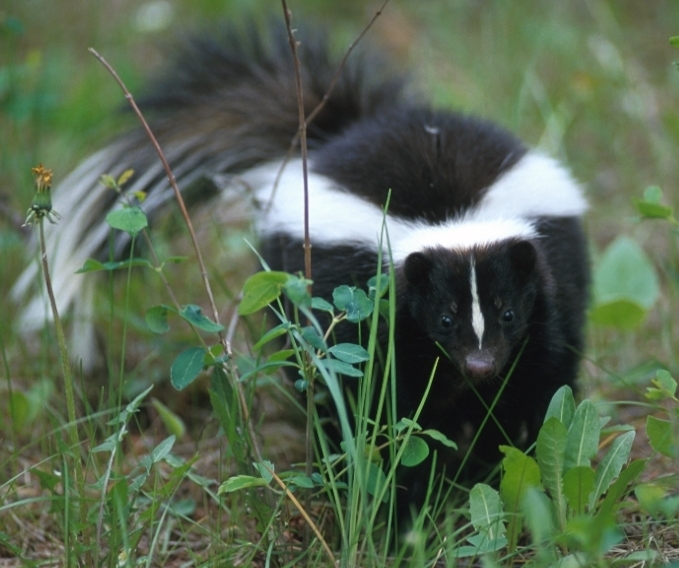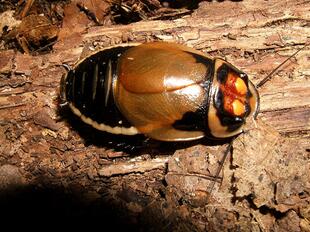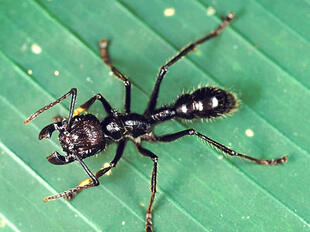
Striped skunk(Mephitis mephitis)
Phylum —chordata
Class — mammalia
Order — carnivora
Family — mephitidae
Genus – mephitis
Appearance
The Striped skunk is a stoutly-built, short-limbed animal with a small, conical head and a long, heavily furred tail. Adult males are 10% larger than females, with both sexes measuring between 52–77 cm in total body length and usually weighing 1.8–4.5 kg (4.0–9.9 lb), though some may weigh 5.5 kg (12 lb).The forefeet are armed with five long, curved claws adapted for digging, while those on the hind feet are shorter and straighter.
The color patterns of the fur vary greatly, but generally consist of a black base with a white stripe extending from the head which divides along the shoulders, continuing along the flanks to the rump and tail. Some specimens have a white patch on the chest, while others bear white stripes on the outer surface of the front limbs. Brown or cream-colored mutations occasionally occur.
Like all skunks, the Striped skunk possesses two highly developed scent glands, one on each side of the anus, containing about 15 milliliters of musk each, which provides a chemical defense against predation. This oily, yellow-colored musk consists of a mixture of powerfully odorous thiols (sulfur analogues of alcohols, in older sources called "mercaptans"), which can be sprayed at a distance of several meters. The odor of this musk was likened by Ernest Thompson Seton to a mixture of perfume musk, essence of garlic, burning sulfur and sewer gas "magnified a thousand times", though Clinton Hart Merriam claimed that it isn't "one tenth" as offensive as that produced by minks and weasels. It can be sprayed at a distance of several meters. If sprayed on the eyes, this compound can cause a temporary burning sensation.
Habitat
Striped skunks are natives of North America and occur from northern Mexico to southern Canada.
Behavior
Skunks are nocturnal solitary animals, and forage and hunt in the evening. During the day, they nest in the abandoned dens that other animals have lived in, or in brush piles or hollowed logs, or underneath buildings. When it is colder, they prefer to remain in underground dens. During winter for extended periods they are inactive but they do not truly hibernate. Docile in nature, they are famous for their defense system of a bad-smelling spray that comes from two glands near the base of their tail. Spraying typically takes place after a warning display, where the skunk stomps its feet and arches its back, at the same time raising its tail. Although these animals are usually silent, they can make a wide range of sounds, including hissing, screeching, churring, growling, twittering, and cooing sound during social interactions or when alarmed.
Diet
The Striped skunk is an omnivore and eats both plants and meat. Its diet includes insects, fish, crustaceans, small mammals, fruits, nuts, grasses leaves and carrion (dead animals).
Reproduction
Striped skunks are polygynous, which means that one male mates with multiple females. After mating, the female no longer associates with the male and becomes aggressive towards him through vocalizing, stamping her feet and sometimes fighting. The breeding season is from February to April, and females typically give birth once a year. A female will sometimes breed for a second time in May, later in the spring, if she has lost her first litter, or she experienced a pseudopregnancy. Gestation is for around 59 to 77 days, starting with delayed implantation that can be as long as 19 days. Litters number 2 to 10 kits. Newborns are helpless and rely completely on their mother. When they are three weeks old their eyes open; at six to seven weeks weaning takes place. Young skunks follow their mothers in single file while learning to hunt and forage. Striped skunks reach sexual maturity when they are ten months old.
The average lifespan of Striped skunks in the wild is 7 years. They can live up to 10 years in human care.
In captivity
It's best to keep a pet skunk indoors, as it won't have its spraying defense against predators. Most people allow their skunks to roam their homes while they are there to monitor them. And some people set up entire rooms, such as a small bedroom, as "skunk playrooms." This way, you can keep most of your skunk's toys and bed in one room and limit its access to parts of your home that are unsafe for it (as well as prevent it from getting into items you don't want damaged).
You can keep your skunk in a large dog kennel whenever you're away from home to make sure it stays safe. However, skunks don't tolerate being housed in a cage for extended periods, so aim to keep its time in the kennel to only a few hours. Furthermore, skunks can be trained to use a litter box like a cat or ferret. So make sure it always has access to its litter box, and plan to scoop out the litter daily.
Ensure that your home is escape-proof to keep your skunk safe. That means closely monitoring any open doors and windows. If your skunk gets loose, it can cover miles in a day. Skunks generally lack a homing instinct, so once your skunk is gone, it likely won't be able to find its way back home. However, you can safely take your pet skunk outdoors on a harness and leash for exercise and enrichment.
As pets, young skunks should be fed several times a day while adult skunks can be fed in the morning and evening. Simply put out their meals in a bowl for them. Consult your veterinarian for the appropriate timing and quantity of food for your particular animal.
There are a few pre-packaged, formulated diets available for skunks. If you aren't using a formulated food, your skunk's diet should be roughly 60% to 70% lean protein, such as cooked chicken, eggs, fish, or feeder insects. The rest of the diet should primarily be fresh, cooked, or thawed frozen vegetables. Avoid canned vegetables with salt.
Nuts, cooked grains, a small amount of dog food, and plain yogurt can also be mixed into the diet. Fruit can be given as a treat but not every day. Avoid chocolate, as it is toxic to skunks. Also, try to offer your skunk foods high in calcium and taurine, or give it supplements that provide these. Consult your vet for the proper dosage.
Finally, skunks need access to a dish of fresh water at all times, though some don't drink a lot. They get much of the water they need from the vegetables in their diet.
Skunks should be spayed or neutered at a young age, usually when they're 3 to 6 months old, to prevent aggression and potential health issues due to their hormones, such as cancer. Removing the scent glands may be done at the same time, though this is often done at an even younger age while the skunks are still with the breeder. Skunks also need to be vaccinated against common dog and cat diseases, such as distemper, as well as dewormed. Your veterinarian should be able to recommend the correct course of vaccinations.
Skunks are prone to a variety of health issues, including seizures, diabetes, allergies, nutritional deficiencies, and obesity. A proper diet can prevent or minimize many of these problems, so regularly discuss your pet’s diet with your vet.
 Russian
Russian
 English
English
























